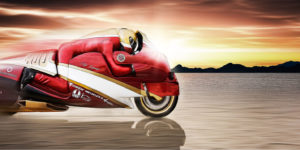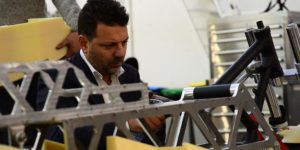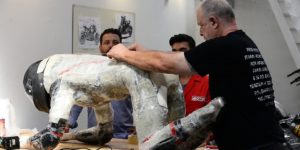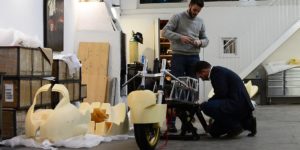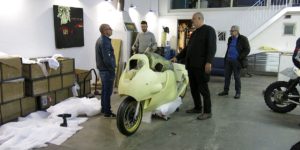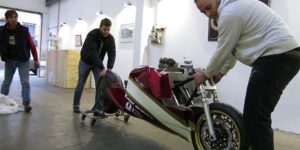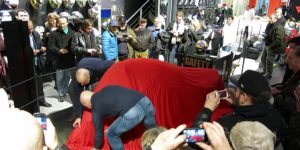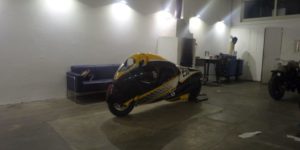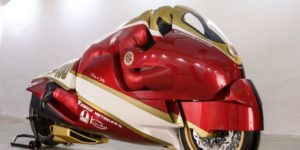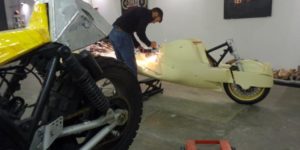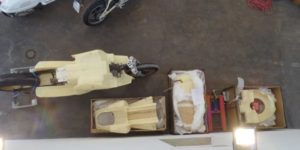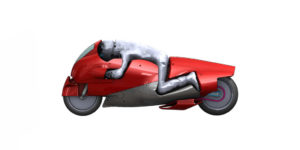Posts Tagged ‘In-Motion’
Record Motor Cycles c1
RECORD MOTOR CYCLES c1

Unveiled at the EICMA 2015, al Dainese D-Store, the 18 November 2015 The concept Record Motor Cycles C1 is the preview of a new ambitious project of Roberto Crepaldi.
The model designed and manufactured by GIVEN design with the technical participation of In-Motion has seen us involved throughout the part of the transformation from the sketch to the final model style, through modeling Hull, 3D scanning pilot, and the reconstruction of the same pilot pattern. All once a more 'perfect integration of the pilot's silhouette with the hull, This respecting and observing the limits imposed by the FIA regulations.
For more information, visit RECORDMOTORCYCLES.COM
In these images you can see the construction phases of the model and the frame needed to scan the real pilot in 3D.
The hull of the processing steps and the frame before painting.
The finished bike in our workshop.
Some pictures of the preparation and presentation of the model.
A "small" depth technical sull'aereodinamica result of Riccardo Capacchione RMC:
THE CASING AND AERODYNAMICS
The most visible component of our bikes Speed Record is definitely the fairing. Also called "hull", It performs a dual function: of course aesthetic and functional aerodynamic efficiency. The aesthetic component is the subject of the designer but is not limited, as you might think, to trace "sexy" lines capable of satisfying the likely customers. Roberto Crepaldi, the creator of Project Recordmotorcycles, He drew the first sketches of style with the classic white of the paper and charcoal system. These were then processed digitally by our Donato Cannatello, a specialist in this area (www.given.it), to be edited and revised quickly. Donato has also carried out a 3D scanning of the entire motorcycle-pilot system for performing a dimensional analysis and performance of the aerodynamic flows and further has made "solid" prints 3 Dimensions of each considered critical component of the overall design economy, Also to achieve the "tactile" made of partly drawn to CAD.
The opposite of Flight
As we said, the fairing design must take into account the very important function performed by this "cover" that wraps the bike. We refer to the aerodynamic efficiency, since the profile of the bike is nothing but an airfoil upside down ... (see Glossary, At bottom). The front fender is considered an integral part of the fairing as, excluding the tire, is the component responsible to "open" the air during the race.
The fluid in which the motorcycle moves, prosaically said "air", It opposes the motion of the ... motion, and this resistance increases with the square of the speed: if we double the speed, the Fr-resistant aerodynamic force will increase by four times and so on, exponentially. Try putting a hand out the window of a speeding car, a 130 km / h. The push on the palm is already significant, now imagine a 450 km / h or so what is the magnitude of the forces with which he has to do.
The fender then "open" the air stream, funneling it on the sides of the fairing and the fairing. The particular form of our "fender" also generates a downward thrust, detta "deportanza" (downforce), which compresses the tire on the road surface, avoiding that the motion raises the muzzle, just when our driver would not like. This is a force directly applied on the wheel, given that the mudguard is fixed to the fork portion "resting" on the ground and is therefore particularly effective. The same function is performed by fairing, however, that "pushes" on the motorcycle portion which is located "above" the suspensions of this and our designer, l’Ing. Giulio Bernardelle, must consider (It took account ...) in the calculation of the fork springs, calls to support the maximum speed a much higher load than that measurable in motion stops. The downforce generated by the fairing will therefore have a lower real effect than that of the front fender but being much greater exposed surface, the thrust will still be considerable.
The importance of harmonious hips
The fairing receives the airflow coming from the fender on the flanks duly connected. Their shape prevents the airflow moves in a disorderly manner and protects, as does the fairing for the upper portion, the pilot. Boots, legs, arms, helmet, shoulders, so they are "under" the powerful air stream and not create unpredictable eddies, which may disturb the stability of the bike. In fact, the air flowing in direct contact with the surfaces of the fairing moves whirling motion creating a layer - as thin as possible - where the vortices chase, slipping towards the rear part of the bike. . Above this "boundary layer", If the casing is well designed, the air is moving in a much more orderly, said "laminar flow", which greatly improves the aerodynamic efficiency of the bike. It is a very important aspect and is one of the compromises in the design has been forced to accept. Not being able to completely reduce the flow of air in "laminar" trying to minimize the swirling and the reason is all right: to generate vortices is necessary to draw energy from somewhere (think about the hurricanes that feed the sea warmth and vanish when this is absent), and the only available energy is produced by our V8 engine. This means that a part (remarkable) Power is spending "to run the air" and not to accelerate the bike. Also vortices which undermines stability, in addition to being a little effect pleasing to the pilot at least as much as the surge described above, It is another way to subtract energy to the motor.
The sides saran beautiful, but the tail ...
Apart from the sides of the hull pigtail "closes" the airflow in which the motorcycle moves, so as not to generate vortices in the rear portion. As repeated far, the turbulence slows the bike, in this case as if there was a "giant hand" pulling back the vehicle. Our tail is very high, but we would have drawn even higher to achieve maximum efficiency. There are limits, however,, imposed by Regulation, I precisi. The tail can not be higher (measuring from the ground) than twice the radius of the wheel. The form that would be expected for the part of the pigtail terminal is the "drop", a curved profile that closes the silhouette, filleting forms according smooth lines. Well, this solution would benefit if the length of the entire motorcycle silhouette was at least seven times greater than the midship section. A moment, we explain.
The "main section" is the largest detected surface on a plane perpendicular to the longitudinal axis of the bike. Still too "messy" explanation? Think then of "slicing" the bike, as you would with a gigantic mortadella. The, him, "Largest slice" represents the midship section and given that, unlike ... mortadella, this slice will not be a perfect circle, we must consider the two perimeter points most distant from each other. This is the portion to be used to calculate the minimum length of the motorcycle in the case you want to realize the so-called "drop".
Proceeding with this method the total length would be far superior to eight meters, impractical for a long series of reasons. Just to name one, think of the pair of right yaw which would cause a lateral gust of wind ...
If it does not work, better to "cut off" ...
The best way is to "cut" in a clear way the outline of the motorcycle, thus obtaining the "truncated tail". You notto that all cars have not a drop of back design, but ending with a sharp vertical line? Now you know why.
Finally, the truncated tail also has its limits and aerodynamic vortices behind it are created and how, because the area just behind the motorcycle is of low atmospheric pressure. The air is "sucked" in its interior on each side in whirling motions that are a real aerodynamic brake. That's why our tailpipes "blow" in this area, coming out from the back of the tail: increasing the pressure in this area thanks to the hot gases coming from the engine, limit of a lot of the harmful effect of the vortices. If at this point you have not wondered what it is that element placed under the hull in front of the rear wheel, We will we say: it is a component that contains the engine cooling radiators. Harness the high pressure zone located anteriorly and that of low pressure immediately behind the "container". The pressure difference is thus exploited to accelerate the flow of air that is as easy to "pass" the sockets on the front element and which convey the aerodynamic jet inside, right where the radiators are arranged. The low pressure portion that is created just behind the conveyor, sucks the air contained within, helping to create a powerful airflow that cools the refrigerant flowing into the radiators. When we want, we are just brilliant, vero?
Finally, a short glossary "aerodynamic":
DRAG: is the ability to "dig" (referring to the English verb) the air, opening a "pass" for the bike.
CX: it is a coefficient calculated which represents the aerodynamic penetration capacity of a vehicle. In its calculation it is taken into account also the "Drag".
BOUNDARY LAYER: It is the surface which divides the air layer in swirling and then uncontrolled movement, one in which the fluid (the air) moves in an orderly manner, as if it were composed of "blades", just.
DEPORTANZA: It is the strength of the vertical direction with respect to the ground, generated due to the difference in pressure between two surfaces. In the aircraft the airfoil generates an identical strength, but contrary, lift. Given that the wing is at the top and flat curve in the lower part, the air must accelerate along the upper surface to rejoin at the end of the wing with the part of the stream that flows over the flat face. For the Bernoulli, a vacuum is created in the upper part of the wing and a "pressure" then at the bottom. This pushes the plane upwards. In a motorcycle (self) it exploits the same principle, but on the contrary, to keep the vehicle close to the ground.
Given the sophisticated technologies used for the design and construction of every detail of the bike, It updated with the upgrade of colors, Also they have supplanted the classic white black and w. Seriously, pencil between the hands and the sheet of paper are a reference material almost indispensable for many designers. Ub point of transition between the union and bolder thinking, the real world and finally the confrontation with the technology available (and costs), the inflexible entity that borders within finite boundaries immateriality of creative thinking. in conclusion, the sketch makes visible the idea and allows the engineer to understand which are the most suitable for the project and feasibility of new solutions or technologies, more often, proposed again in new forms and combinations.
The design of a fairing actually starts from the front wing. This applies to all bikes and especially for our, because the speeds involved during the "Speed Attack" will be far superior to those reached definitely from any street bike but also by a MotoGP. During the launch at the maximum speed, we face a real "air wall": the aerodynamic resistance in a fluid (the air, in other words) It increases with the square of the speed. To be clear, traveling at 10 km / h the air generates a date Fr force that opposes the motion of the bike .... If the passassimo 20 km / h, resistant aerodynamic force becomes four times that measured in 10 km / h. Going to 40 km / h, Fr corresponds to the 16 Fr times the detectable 10 km/(h, etc.. A 450 km / h, imagine the intensity of the aerodynamic force that "push" on the face of our bike!
Try putting a hand out the window of a car at a speed 100 km / h (or so) and you have the perception of aerodynamic lift to a certainly not very high speed. While you're at, try to orient the palm, by exposing it to air and then completely turning his hand and will verify how the strength changes by changing the exposed surface of the hand.
To understand the crucial role of the different components of the fairing or better, of our bike superstructures, imagine being on the saddle and cross a vertical plane in space. Just after the front tire (if it says "lo", vero, but it is horrible to read and hear ...) reaches over 400 km / h the fender, whose design contributes to move towards the outer sides and upward the air molecules. The boost aerodynamics, in addition to brake the advancement of motion, pushes down the fender that, It is constrained to the fork, It maintains contact between rubber and soil. The fairing performs a similar function, "Opening" the air stream in a more coherent and less turbulent as possible. It, too, thanks to its shape generates a force directed at 90 ° with respect to the ground but, It is constrained to the upper part of the bike which is not in direct contact with the ground (unsprung mass), the thrust that if it draws acts on compressing suspensions and this must be taken into account in the moment in which our engineer will decide the "k", the elastic constant (or hardness, you do..) of the fork springs.









